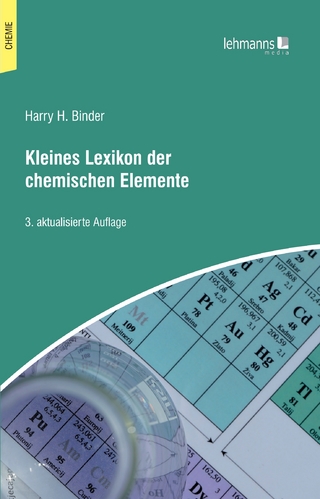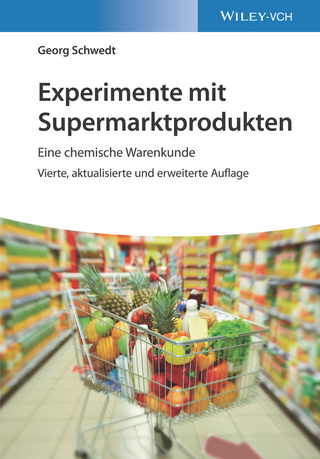
Chemistry
John Wiley & Sons Inc (Verlag)
978-0-471-65552-7 (ISBN)
- Titel ist leider vergriffen;
keine Neuauflage - Artikel merken
This book helps you promote a spirit of scientific discovery. New scientific discoveries do not usually begin with models; they begin with data and a spirit of intellectual curiosity. In much the same way, Spencer, Bodner, and Rickard's "Chemistry: Structure and Dynamics, Third Edition" presents data, and challenges students to derive the models. Built on the recommendations of the American Chemical Society's "Task Force on the General Chemistry Curriculum", this innovative approach helps students get a feel for how chemists approach problems in the real world. This Third Edition is now revised with a new chapter on materials science and increased coverage of nuclear chemistry.Here's how it works: Data-driven approach - unlike traditional books that present theory, questions, and then applications, this text starts with the data and derives the theory from it.
Students start with observations, just like scientists; concise, flexible format - the text is briefer than most current general chemistry texts (Coverage focuses on the core topics of general chemistry, with optional coverage of special topics also available); and, an emphasis on core themes - these themes include the process of science, the relationship between molecular structure and physical/chemical properties, and the relationship between the microscopic and macroscopic levels.Also available "Chemistry: A Guided Inquiry, Third Edition" By Richard S. Moog and John J. Farrell. Using a classroom-guided inquiry approach, this ideal accompaniment to "Chemistry: Structure and Dynamics" features 62 ChemActivities covering all the core general chemistry topics. These ChemActivities provide a variety of ways to promote a student-focused, active classroom.
Chapter 1. Elements and Compounds. 1.1 Chemistry: A Definition. 1.2 Elements, Compounds, and Mixtures. 1.3 Atomic Symbols. 1.4 Chemical Formulas. 1.5 Evidence for the Existence of Atoms. 1.6 The Structure of Atoms. 1.7 Atomic Number and Mass Number. 1.8 Isotopes. 1.9 The Difference between Atoms and Ions. 1.10 Polyatomic Ions. 1.11 Predicting the Formulas of Ionic Compounds. 1.12 The Periodic Table. 1.13 The Macroscopic, Atomic, and Symbolic Worlds of Chemistry. 1.14 The Mass of an Atom. 1.15 The Mole as the Bridge between the Macroscopic and Atomic Scales. 1.16 The Mole as a Collection of Atoms. 1.17 Converting Grams into Moles and Number of Atoms. 1.18 The Mole as a Collection of Molecules. 1.19 Percent Mass. 1.20 Determining the Formula of a Compound. 1.21 Elemental Analysis. Problems. Chapter 2. The Mole: The Link between the Macroscopic and the Atomic World of Chemistry. 2.1 Chemical Reactions and the Law of Conservation of Atoms. 2.2 Chemical Equations as a Representation of Chemical Reactions. 2.3 Two Views of Chemical Equations: Molecules Versus Moles. 2.4 Balancing Chemical Equations. 2.5 Mole Ratios and Chemical Equations. 2.6 Stoichiometry. Chemistry in the World Around Us: The Stoichiometry of the Breathalyzer. 2.7 The Nuts and Bolts of Limiting Reagents. 2.8 Density. 2.9 Solute, Solvent, and Solution. 2.10 Concentration. 2.11 Molarity as a Way of Counting Particles in Solution. 2.12 Dilution Calculations. 2.13 Solution Stoichiometry. Problems. Chapter 3. The Structure of the Atom. 3.1 Rutherford's Model of the Atom. 3.2 Particles and Waves. 3.3 Light and Other Forms of Electromagnetic Radiation. 3.4 Atomic Spectra. 3.5 Quantization of Energy. 3.6 The Bohr Model of the Atom. 3.7 The Energy States of the Hydrogen Atom. Chemistry in the World Around Us: Color. 3.8 The First Ionization Energy. 3.9 The Shell Model. 3.10 The Shell Model and the Periodic Table. 3.11 Photoelectron Spectroscopy and the Structure of Atoms. 3.12 Electron Configurations from Photoelectron Spectroscopy. 3.13 Allowed Combinations of Quantum Numbers. 3.14 Shells and Subshells of Orbitals. 3.15 Orbitals and the Pauli Exclusion Principle. 3.16 Predicting Electron Configurations. 3.17 Electron Configurations and the Periodic Table. 3.18 Electron Configurations and Hund's Rules. 3.19 The Sizes of Atoms: Metallic Radii. 3.20 The Sizes of Atoms: Covalent Radii. 3.21 The Relative Sizes of Atoms and Their Ions. 3.22 Patterns in Ionic Radii. 3.23 Second, Third, Fourth, and Higher Ionization Energies. 3.24 Average Valence Electron Energy (AVEE). 3.25 AVEE and Metallicity. Problems. Chapter 4. The Covalent Bond. 4.1 Valence Electrons. 4.2 The Covalent Bond. 4.3 How Does the Sharing of Electrons Bond Atoms? 4.4 Using Lewis Structures to Understand the Formation of Bonds. 4.5 Drawing Skeleton Structures. 4.6 A Step-by-Step Approach to Writing Lewis Structures. 4.7 Molecules That Don't Seem to Satisfy the Octet Rule. 4.8 Bond Lengths. 4.9 Resonance Hybrids. 4.10 Electronegativity. 4.11 Partial Charge. 4.12 Formal Charge 4.13 The Shapes of Molecules. Chemistry in the World Around Us: The Shapes of Molecules. 4.14 Predicting the Shapes of Molecules (the Electron Domain Model). 4.15 The Role of Nonbonding Electrons in the ED Model. 4.16 Bond Angles. 4.17 The Difference Between Polar Bonds and Polar Molecules. Problems. SPECIAL TOPICS. 4A.1 Valence Bond Theory. 4A.2 Hybrid Atomic Orbitals. 4A.3 Molecules with Double and Triple Bonds. 4A.4 Molecular Orbital Theory. Problems. Chapter 5. Ionic and Metallic Bonds. 5.1 Metals, Nonmetals, and Semimetals. 5.2 The Active Metals. 5.3 Main-Group Metals and Their Ions. 5.4 Main-Group Nonmetals and Their Ions. 5.5 Transition Metals and Their Ions. Chemistry in the World Around Us: Paints and Pigments. 5.6 Predicting the Products of Reactions That Produce Ionic Compounds. 5.7 Oxides, Peroxides, and Superoxides. 5.8 The Ionic Bond. 5.9 Structures of Ionic Compounds. 5.10 Metallic Bonds. 5.11 The Relationship among Ionic, Covalent, and Metallic Bonds. 5.12 Bond-Type Triangles. 5.13 Properties of Metallic, Covalent, and Ionic Compounds. 5.14 Oxidation Numbers. 5.15 Calculating Oxidation Numbers. 5.16 Oxidation-Reduction Reactions. 5.17 Nomenclature. Problems. Chapter 6. Gases. 6.1 Temperature. 6.2 Temperature as a Property of Matter. 6.3 The States of Matter. 6.4 Elements or Compounds That Are Gases at Room Temperature. 6.5 The Properties of Gases. 6.6 Pressure versus Force. 6.7 Atmospheric Pressure. 6.8 Boyle's Law. 6.9 Amontons' Law. 6.10 Charles' Law. 6.11 Gay-Lussac's Law. 6.12 Avogadro's Hypothesis. 6.13 The Ideal Gas Equation. 6.14 Ideal Gas Calculations: Part I. Chemistry in the World Around Us: Nitrous Oxide or "Laughing Gas". 6.15 Ideal Gas Calculations: Part II. 6.16 Dalton's Law of Partial Pressures. 6.17 The Kinetic Molecular Theory. 6.18 How the Kinetic Molecular Theory Explains the Gas Laws. Problems. SPECIAL TOPICS. 6A.1 Graham's Laws of Diffusion and Effusion. 6A.2 Deviations from Ideal Gas Law Behavior: The van der Waals Equation. 6A.3 Analysis of the van der Waals Constants. Problems. Chapter 7. Making and Breaking of Bonds. 7.1 Energy. 7.2 Heat. 7.3 Heat and the Kinetic Molecular Theory. 7.4 The First Law of Thermodynamics. 7.5 State Functions. 7.6 The Enthalpy of a System. 7.7 Specific Heat. 7.8 Enthalpies of Reaction. 7.9 Enthalpy as a State Function. 7.10 Standard-State Enthalpies of Reaction. 7.11 Calculating Enthalpies of Reaction. 7.12 Enthalpies of Atom Combination. 7.13 Using Enthalpies of Atom Combination to Probe Chemical Reactions. 7.14 Bond Length and the Enthalpy of Atom Combination. 7.15 Hess's Law. 7.16 Enthalpies of Formation. Problems. Chapter 8. Liquids and Solutions. 8.1 The Structure of Gases, Liquids, and Solids. 8.2 Intermolecular Forces. 8.3 Relative Strengths of Intermolecular Forces. 8.4 The Kinetic Theory of Liquids. 8.5 The Vapor Pressure of a Liquid. 8.6 Melting Point and Freezing Point. 8.7 Boiling Point. 8.8 Phase Diagrams. 8.9 Hydrogen Bonding and the Anomalous Properties of Water. 8.10 Solutions: Like Dissolves Like. 8.11 Why Do Some Solids Dissolve in Water? 8.12 Solubility Equilibria. 8.13 Solubility Rules. 8.14 Net Ionic Equations. 8.15 Hydrophilic and Hydrophobic Molecules. Chemistry in the World Around Us: Soaps, Detergents, and Dry-Cleaning Agents. Problems. SPECIAL TOPICS. 8A.1 Colligative Properties. 8A.2 Depression of the Partial Pressure of a Solvent. 8A.3 Boiling Point Elevation. 8A.4 Freezing Point Depression. Problems. Chapter 9. Solids. 9.1 Solids. 9.2 Molecular and Network Covalent Solids. 9.3 The Relationship between the Physical Properties of Molecular and Network Covalent Solids. 9.4 Metallic Solids. 9.5 Physical Properties That Result from the Structure of Metals. 9.6 The Structure of Metals. 9.7 Coordination Numbers and the Structures of Metals. 9.8 Unit Cells: The Simplest Repeating Unit in a Crystal. 9.9 Solid Solutions and Intermetallic Compounds. 9.10 Semimetals. 9.11 Ionic Solids. 9.12 The Search for New Materials. Chemistry in the World Around Us: The Search for High Temperature Superconductors. 9.13 Measuring the Distance between Particles in a Unit Cell. 9.14 Determining the Unit Cell of a Crystal. 9.15 Calculating the Size of an Atom or Ion. Problems. SPECIAL TOPICS. 9A.1 Defects. 9A.2 Metals, Semiconductors, and Insulators. 9A.3 Thermal Conductivity. 9A.4 Thermal Expansion. 9A.5 Glass and Other Ceramics. Problems. Chapter 10. An Introduction to Kinetics and Equilibrium. 10.1 Reactions That Don't Go to Completion. 10.2 Gas Phase Reactions. 10.3 The Rate of a Chemical Reaction. 10.4 The Collision Theory of Gas Phase Reactions. 10.5 Equilibrium Constant Expressions. 10.6 Reaction Quotients: A Way to Decide Whether a Reaction Is at Equilibrium. 10.7 Changes in Concentration That Occur as a Reaction Comes to Equilibrium. 10.8 Hidden Assumptions That Make Equilibrium Calculations Easier. 10.9 The Effect of Temperature on an Equilibrium Constant. 10.10 Le Chatelier's Principle. 10.11 Le Chatelier's Principle and the Haber Process. 10.12 What Happens When a Solid Dissolves in Water? 10.13 The Solubility Product Expression. 10.14 The Relationship between Ksp and the Solubility of a Salt. 10.15 The Role of the Ion Product (Qsp) in Solubility Calculations. 10.16 The Common-Ion Effect. Problems. SPECIAL TOPICS. 10A.1 A Rule of Thumb for Testing the Validity of Assumptions. 10A.2 What Do We Do When the Approximation Fails? Problems. Chapter 11. Acids and Bases. 11.1 Properties of Acids and Bases. 11.2 The Arrhenius Definition of Acids and Bases. 11.3 The Bronsted-Lowry Definition of Acids and Bases. 11.4 Conjugate Acid-Base Pairs. 11.5 The Role of Water in the Bronsted Model. 11.6 To What Extent Does Water Dissociate to Form Ions? 11.7 pH as a Measure of the Concentration of H3O- Ion. 11.8 Relative Strengths of Acids and Bases. 11.9 Relative Strengths of Conjugate Acid-Base Pairs. 11.10 Relative Strengths of Different Acids and Bases. 11.11 Relationship of Structure to Relative Strengths of Acids and Bases. 11.12 Strong Acid pH Calculations. 11.13 Weak Acid pH Calculations. 11.14 Base pH Calculations. 11.15 Mixtures of Acids and Bases: Buffers. 11.16 Buffers and Buffer Capacity. Chemistry in the World Around Us: Buffers in The Body. 11.17 Acid-Base Reactions. 11.18 pH Titration Curves. Problems. SPECIAL TOPICS. 11A.1 Diprotic Acids. 11A.2 Diprotic Bases. 11A.3 Compounds That Could Be Either Acids or Bases. Problems. Chapter 12. Oxidation-Reduction Reactions. 12.1 Common Oxidation-Reduction Reactions. 12.2 Determining Oxidation Numbers. 12.3 Recognizing Oxidation-Reduction Reactions. 12.4 Voltaic Cells. 12.5 Oxidizing and Reducing Agents. 12.6 Relative Strengths of Oxidizing and Reducing Agents. 12.7 Standard Cell Potentials. Chemistry in the World Around Us: Batteries. 12.8 Electrochemical Cells at Nonstandard Conditions: The Nernst Equation. 12.9 Electrolysis and Faraday's Law. 12.13 Balancing Oxidation-Reduction Equations. 12.14 Redox Reactions in Acidic Solutions. 12.15 Redox Reactions in Basic Solutions. 12.16 Molecular Redox Reactions. Problems. SPECIAL TOPICS. 12A.1 Electrolysis of Molten NaCl. 12A.2 Electrolysis of Aqueous NaCl. 12A.3 Electrolysis of Water. Problems. Chapter 13. Chemical Thermodynamics. 13.1 Spontaneous Chemical and Physical Processes. 13.2 Entropy and Disorder. 13.3 Entropy and the Second Law of Thermodynamics. 13.4 Standard-State Entropies of Reaction. 13.5 The Third Law of Thermodynamics. 13.6 Calculating Entropy Changes for Chemical Reactions. 13.7 Gibbs Free Energy. 13.8 The Effect of Temperature on the Free Energy of a Reaction. 13.9 Beware of Oversimplifications. 13.10 Standard-State Free Energies of Reaction. 13.11 Equilibria Expressed in Partial Pressures. 13.12 Interpreting Standard-State Free Energy of Reaction Data. 13.13 The Relationship Between Free Energy and Equilibrium Constants. 13.14 The Temperature Dependence of Equilibrium Constants. 13.15 Gibbs Free Energies of Formation and Absolute Entropies. Problems. Chapter 14. Kinetics. 14.1 The Forces That Control a Chemical Reaction. 14.2 Chemical Kinetics. 14.3 Is the Rate of Reaction Constant? 14.4 Instantaneous Rates of Reaction. 14.5 Rate Laws and Rate Constants. 14.6 A Physical Analog of Kinetic Systems. 14.7 The Rate Law versus the Stoichiometry of a Reaction. 14.8 Order and Molecularity. 14.9 A Collision Theory of Chemical Reactions. 14.10 The Mechanisms of Chemical Reactions. 14.11 Zero-Order Reactions. 14.12 Determining the Order of a Reaction from Rates of Reaction. 14.13 The Integrated Form of Zero-, First-, and Second-Order Rate Laws. 14.14 Determining the Order of a Reaction with the Integrated Form of Rate Laws. 14.15 Reactions That Are First Order in Two Reactants. 14.16 The Activation Energy of Chemical Reactions. Chemistry in the World Around Us: NO and NO2 in the Atmosphere. 14.17 Catalysts and the Rates of Chemical Reactions. 14.18 Determining the Activation Energy of a Reaction. 14.19 The Kinetics of Enzyme-Catalyzed Reactions. Problems. SPECIAL TOPICS. 14A.1 Deriving the Integrated Rate Laws. Chapter 15. Nuclear Chemistry. 15.1 Radioactivity. 15.2 The Structure of the Atom. 15.3 Modes of Radioactive Decay. 15.4 Neutron-Rich versus Neutron-Poor Nuclides. 15.5 Binding Energy Calculations. 15.6 The Kinetics of Radioactive Decay. 15.7 Dating by Radioactive Decay. 15.8 Ionizing versus Nonionizing Radiation. 15.9 Biological Effects of Ionizing Radiation. 15.10 Natural versus Induced Radioactivity. 15.11 Nuclear Fission. 15.12 Nuclear Fusion. 15.13 Nuclear Synthesis. Chemistry in the World Around Us: Nuclear Medicine. Problems. Chapter 16. Chemical Analysis. 16.1 Methods of Analysis. 16.2 Separation of Mixtures. 16.3 The Olive Oil Caper. 16.4 The Great Apple Scare of '89. 16.5 Fighting Crime with Chemistry. 16.6 Interaction of Electromagnetic Radiation with Matter: Spectroscopy. 16.7 The Fox River Mystery. 16.8 An Off-Color Fatty Alcohol. 16.9 The Search for New Compounds. 16.10 The Search for the Northwest Passage-The Franklin Expedition. 16.11 Dead Cats. Problems. Appendix A. A.1 Systems of Units. English Units of Measurement. The Metric System. SI Units of Measurement. Derived SI Units. Non-SI Units. A.2 Uncertainty in Measurement. Systematic and Random Errors/Accuracy and Precision. Accuracy and Precision. A.3 Significant Figures. Addition and Subtraction with Significant Figures. Multiplication and Division with Significant Figures. The Difference between Measurements and Definitions. Rounding off. A.4 Scientific Notation. A.5 The Graphical Treatment of Data. A.6 Significant Figures and Unit Conversion Worksheet. Significant Figures. Unit Conversion. Appendix B. Table B.1 Values of Selected Fundamental Constants. Table B.2 Selected Conversion Factors. Table B.3 The Vapor Pressure of Water. Table B.4 Radii of Atoms and Ions. Table B.5 Ionization Energies. Table B.6 Electron Affinities. Table B.7 Electronegativities. Table B.8 Acid-Dissociation Equilibrium Constants. Table B.9 Base-Ionization Constants. Table B.10 Solubility Product Equilibrium Constants. Table B.11 Complex Formation Equilibrium Constants. Table B.12 Standard Reduction Potentials. Table B.13 Standard-State Enthalpies, Free Energies, and Entropies of Atom Combination. Table B.14 Bond-Dissociation Enthalpies. Table B.15 Electron Configurations of the First Elements. Table B.16 Standard-State Enthalpies, Free Energies, and Entropies of Formation. Appendix C. Answers to Selected Problems. Appendix D. Answers to Checkpoints. Photo Credits. Index. Modules (available at www.wiley.com/college/spencer). Module 1. Chemistry of the Nonmetals. Module 2. Transition Metal Chemistry. Module 3. Complex Ion Equilibria. Module 4. Organic Chemistry: Structure and Nomenclature of Hydrocarbons. Module 5. Organic Chemistry: Functional Groups. Module 6. Organic Chemistry: Reaction Mechanisms. Module 7. Polymer Chemistry. Module 8. Biochemistry.
| Erscheint lt. Verlag | 26.8.2005 |
|---|---|
| Zusatzinfo | Illustrations |
| Verlagsort | New York |
| Sprache | englisch |
| Maße | 220 x 281 mm |
| Gewicht | 2016 g |
| Einbandart | gebunden |
| Themenwelt | Naturwissenschaften ► Chemie ► Allgemeines / Lexika |
| ISBN-10 | 0-471-65552-X / 047165552X |
| ISBN-13 | 978-0-471-65552-7 / 9780471655527 |
| Zustand | Neuware |
| Haben Sie eine Frage zum Produkt? |
aus dem Bereich


